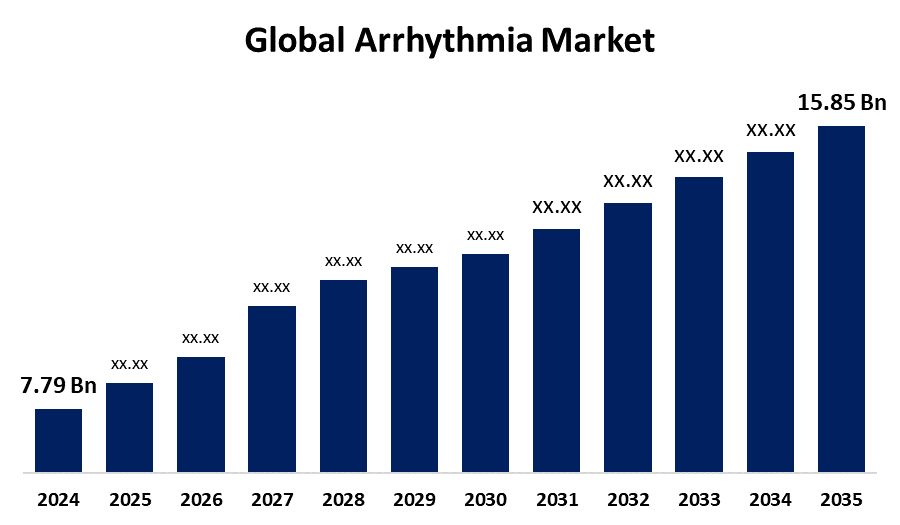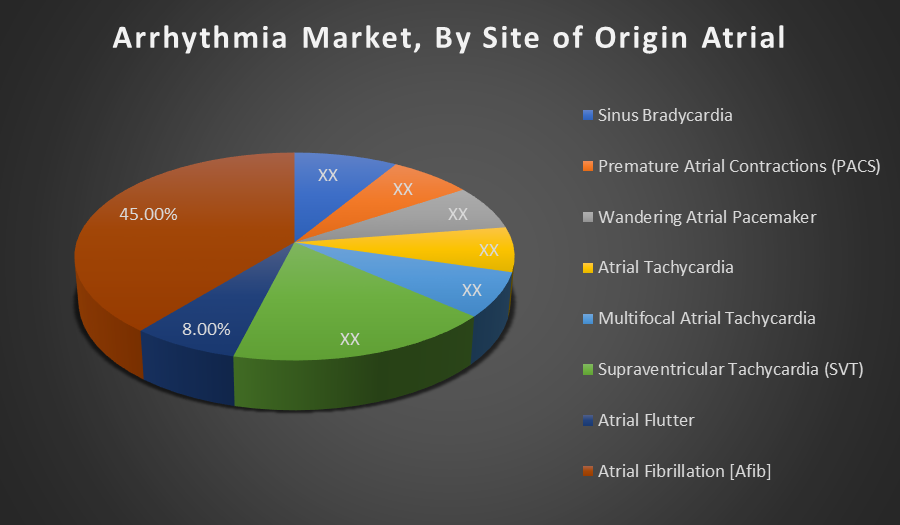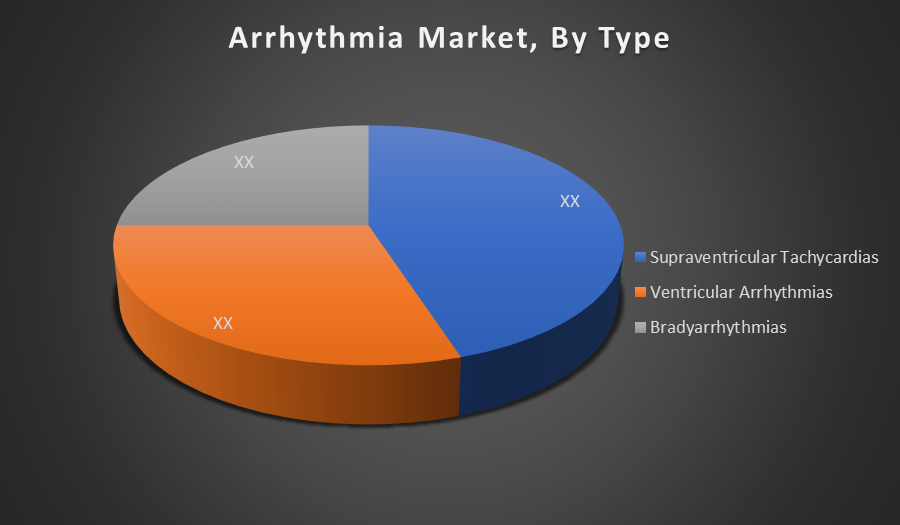- As per Spherical Insights & Consulting, The Global Arrhythmia Market is expected to Grow from USD 7.79 Billion in 2024 to USD 15.85 Billion by 2035, at a CAGR of 6.67% during the forecast period 2025 to 2035, owing to the launch of new therapies in the market and the rise in the number of cases.
- The leading Arrhythmia Market Companies such as Medtronic, Abbott Laboratories, Boston Scientific, Johnson & Johnson, Biotronik, GE Healthcare, Philips Healthcare, Siemens Healthineers, Acutus Medical, MicroPort Scientific, Lepu Medical, Osypka Medical, CardioFocus, Biosense Webster, ZOLL Medical, and Others.
Arrhythmia Treatment Market: Understanding and Treatment Algorithm:
Arrhythmia is a condition where the heart beats irregularly, too fast, too slow, or unevenly due to disrupted electrical signals that control heart rhythm. It can range from harmless to life-threatening and may cause symptoms like palpitations, dizziness, or fainting. Common types include atrial fibrillation, bradycardia, and ventricular tachycardia.

Arrhythmia Diagnosis:
Diagnosis of arrhythmia involves evaluating symptoms and using tests to assess heart rhythm. Common diagnostic tools include electrocardiogram (ECG), Holter monitor, event recorder, and electrophysiological studies. These tests help identify the type, frequency, and cause of abnormal heartbeats, guiding treatment decisions based on severity, underlying conditions, and patient risk factors.
Arrhythmia Treatment
Treatment of arrhythmia depends on its type and severity, aiming to restore normal heart rhythm and prevent complications. Options include medications like antiarrhythmics or beta-blockers, lifestyle changes, and procedures such as catheter ablation or implantable devices like pacemakers and defibrillators. Treatment is personalized based on the patient’s condition and overall health.
Arrhythmia Epidemiology
The disease epidemiology covered in the report provides historical as well as forecasted epidemiology segmented by Total Diagnosed Incident Population of Arrhythmia, Gender-specific Diagnosed Incidence of Arrhythmia, Type-specific Diagnosed Incidence of Arrhythmia, Age-specific Diagnosed Incidence of Arrhythmia, Diagnosed Incident Population based on Primary Site of Arrhythmia, and Diagnosed Incident Population based on Histologic Classification of Arrhythmia Tumour in the global market covering North America, Europe, Asia-Pacific, Latin America, the Middle East, and Africa from 2024 to 2035.
Principal Insights
This section offers a global overview of arrhythmia prevalence data and finding across key region worldwide,
Country wise arrhythmia Multiforme Epidemiology
Country Wise- Arrhythmia Multiforme Epidemiology
• The epidemiology segment provides Arrhythmia prevalence data and finding across key region worldwide, including North America, Europe (Germany, France, Italy, Spain, and the united Kingdom), Asia Pacific (including Japan), Latin America, the Middle East, and Africa.
Arrhythmia Recent Developments:
• In July 2025, Boston Scientific announced that the FDA approved expanded labelling for its FARAPULSE Pulsed Field Aviation System.
The update allowed treatment of drug refractory, persistent atrial fibrillation using both FARAWAVE and FARAWAVE NAV catheters. The decision was supported by position ADVANTAGE AF trail results showing high safety and effectiveness. The company also initiated the Re MATCH IDE study for redo ablation cases
Arrhythmia Marketed Drugs:
Amiodarone is a Class III antiarrhythmic medication used to treat and prevent various types of serious ventricular and supraventricular arrhythmias, including atrial fibrillation and ventricular tachycardia. It works by prolonging the action potential duration and refractory period in cardiac tissues. Despite its effectiveness, it is associated with notable long-term side effects.
- Flecainide: Teva Pharmaceuticals
Flecainide is a Class Ic antiarrhythmic agent approved for the prevention and treatment of paroxysmal supraventricular tachycardias and atrial fibrillation. It works by blocking sodium channels to slow electrical conduction in the heart. Flecainide is commonly used in structurally normal hearts and is effective in rhythm control strategies.
- Sotalol: Mylan Pharmaceuticals (a Viatris company)
Sotalol is a beta blocker with Class III antiarrhythmic properties used to manage ventricular arrhythmias and maintain sinus rhythm in atrial fibrillation. It slows the heart rate and prolongs the QT interval. Due to the potential for proarrhythmia, especially torsades de pointes, it requires careful ECG monitoring is required during initiation.
• AP30663: An intravenous, first in class SK channel inhibitor designed tp convert atrial fibrillation to normal sinus rhythm. In a phase 2 trail, the 5mg kg dose achieved over 50% conversion within 90 minutes, with excellent safety and no ventricular arrhythmias clot formation wit a lower bleeding risk compared to current anticoagulants, showing promise in trackling stock risk
• Milvexian: An oral factor inhibitor in phase3 trials targeting thromboembolism prevention in AF patients. It aims to reduce clot formation with a lower bleeding risk compared to current anticoagulants, showing promise in tackling stock risk
• Rotigaptide (ZP 123): A gap junction enhancer peptide under preclinical investigation, seen to increase intercellular electrical conduction in atrial tissue.This mechanism may stabilize rhythms and reduce susceptibility to atrial fibrillation
Arrhythmia Market Outlook
- The arrhythmia market encompasses diagnostic tools, drugs, and medical devices used to detect and treat irregular heart rhythms. It includes solutions for both atrial and ventricular arrhythmias and covers pharmacological therapies, implantable devices, and surgical interventions aimed at restoring normal heart rhythm and preventing complications like stroke or death.
- Key drivers include the rising prevalence of cardiovascular diseases, increasing geriatric population, and technological advancements in arrhythmia monitoring and treatment. Growing awareness, improved diagnosis, and the demand for minimally invasive procedures are also fueling market growth, especially in developed economies with strong healthcare infrastructure and reimbursement systems.
- Opportunities lie in emerging markets with unmet medical needs, telecardiology advancements, and wearable ECG monitoring technologies. The development of personalized and AI-driven arrhythmia therapies, expansion of remote cardiac care, and increased investment in arrhythmia R&D further present lucrative avenues for growth across global healthcare systems.
- Governments worldwide are investing in cardiac health programs, promoting early diagnosis through public awareness campaigns, and supporting R&D via funding grants. Regulatory bodies are also accelerating approval of life-saving arrhythmia treatments through fast-track pathways and orphan drug incentives, especially in high-risk populations.
- High treatment costs and limited access to advanced technologies in low-income regions hinder global market penetration.
- The market is projected to grow due to the increasing prevalence of arrhythmias and widespread adoption of advanced cardiac monitoring and treatment devices.
Arrhythmia Market Segmentation
By Site of Origin Atrial:
- Sinus Bradycardia
- Premature Atrial Contractions (PACS)
- Wandering Atrial Pacemaker
- Atrial Tachycardia
- Multifocal Atrial Tachycardia
- Supraventricular Tachycardia (SVT)
- Atrial Flutter
- Atrial Fibrillation [Afib]

Atrial Fibrillation (AFib) holds the largest market share among atrial arrhythmias due to its high global prevalence, especially among the elderly. AFib is a major risk factor for stroke and heart failure, driving demand for continuous monitoring, anticoagulants, and advanced ablation techniques, boosting treatment adoption and healthcare spending worldwide.
By Type:
- Supraventricular Tachycardias
- Ventricular Arrhythmias
- Bradyarrhythmias

Supraventricular Tachycardias (SVTs) lead the arrhythmia market by type due to their frequency, treatability, and widespread diagnosis. They encompass common conditions like AFib and atrial flutter, which require long-term treatment. The segment benefits from advanced catheter ablation technologies, wearable monitoring devices, and increased awareness among clinicians and patients globally.
Regional Segment Analysis of the Arrhythmia Market
North America holds the largest share of the arrhythmia market, driven by advanced healthcare infrastructure, high awareness, and early adoption of technologies like implantable devices and catheter ablation. The presence of key market players and favourable reimbursement policies also boosts demand. Additionally, the region’s aging population and rising prevalence of atrial fibrillation contribute significantly to its dominant position in the global arrhythmia treatment landscape.
The Asia-Pacific region is experiencing the fastest growth in the arrhythmia market due to improving healthcare access, rising cardiovascular disease prevalence, and expanding medical tourism. Increasing investments in healthcare infrastructure and a growing elderly population fuel market expansion. Moreover, government initiatives for chronic disease management and growing awareness about arrhythmias are accelerating the adoption of advanced diagnostic and therapeutic solutions across emerging economies in this region.
Arrhythmia Market Key Companies
- Medtronic
- Abbott Laboratories
- Boston Scientific
- Johnson & Johnson
- Biotronik
- GE Healthcare
- Philips Healthcare
- Siemens Healthineers
- Acutus Medical
- MicroPort Scientific
- Lepu Medical
- Osypka Medical
- CardioFocus
- Biosense Webster
- ZOLL Medical
- Others
Arrhythmia Therapeutics Market Report Scope
- The Arrhythmia therapeutics market report provides a detailed overview, covering its causes, symptoms, disease progression, and existing treatment options.
- Detailed insights into Arrhythmia’s epidemiology and therapeutic approaches are included.
- Additionally, a comprehensive review of existing and emerging Arrhythmia therapies is provided, including an evaluation of new treatments expected to influence the current Arrhythmia treatment market landscape.
- The report includes a detailed review of the Arrhythmia therapeutics market, both historical and forecasted, highlighting the global drug reach.
- The Patient-Based Arrhythmia Market Forecasting report offers valuable insights into trends shaping the global Arrhythmia market, helping to develop effective business strategies.
Arrhythmia Treatment Market Report Insights
- Forecasting Market Trends Based on Patient Data and Disease Rates
- Arrhythmia Therapeutic Approaches in Arrhythmia
- Review Of Drugs in Development for Arrhythmia
- Market, Growth, and Trends in Arrhythmia
- Market Opportunities in Arrhythmia Treatment
- Effects Of Future Therapies on Arrhythmia Treatment.
Arrhythmia Treatment Market Report Key Strengths
- 15 Years Arrhythmia Market Forecast
- Global Coverage
- Arrhythmia Epidemiology Segmentation
- Key Cross Competition
Arrhythmia Treatment Market Report Assessment
- Present Practices in the Arrhythmia Treatment Market
- Review of Investigational Arrhythmia Drugs
- Attractiveness of the Arrhythmia Drug Market
- Arrhythmia Market Drivers
- Arrhythmia Market Barriers
- SWOT
- Attribute Analysis
Market Segment
This study forecasts revenue at the global, regional, and country levels from 2020 to 2035. Spherical Insights has segmented the Arrhythmia market based on the below-mentioned segments:
Global Arrhythmia Market, By Treatment Type
Global Arrhythmia Market, By Cancer Type
Global Arrhythmia Market, By Regional Analysis
- North America
- Europe
- Germany
- UK
- France
- Italy
- Spain
- Russia
- Rest of Europe
- Asia Pacific
- China
- Japan
- India
- South Korea
- Australia
- Rest of Asia Pacific
- South America
- Brazil
- Argentina
- Rest of South America
- Middle East & Africa
- UAE
- Saudi Arabia
- Qatar
- South Africa
- Rest of the Middle East & Africa






